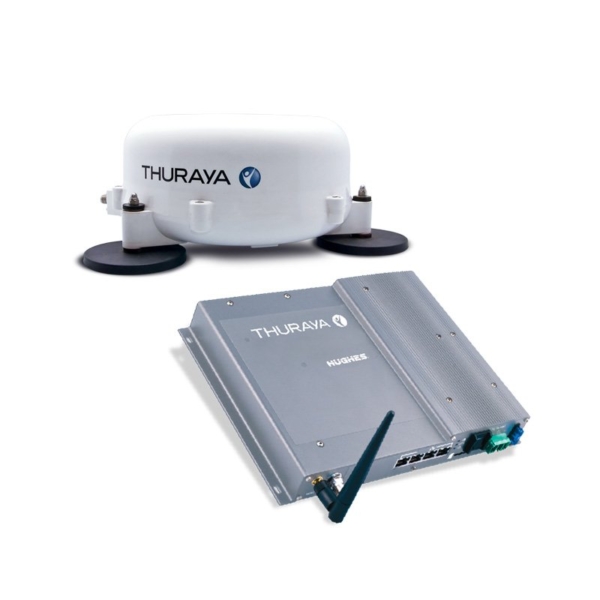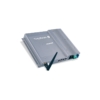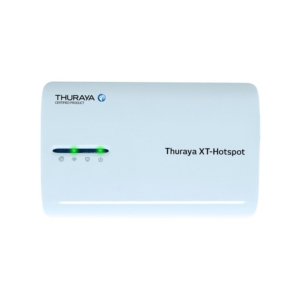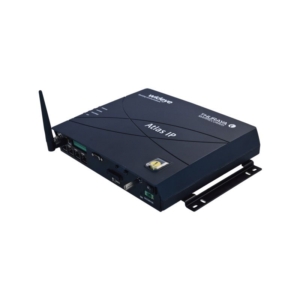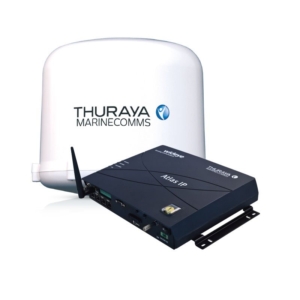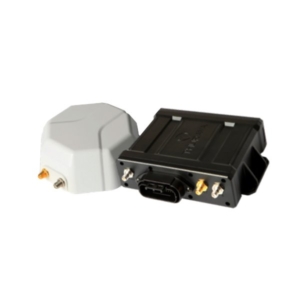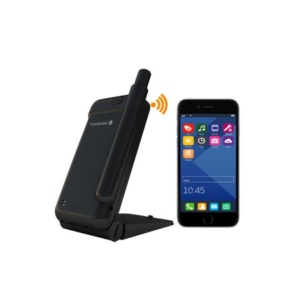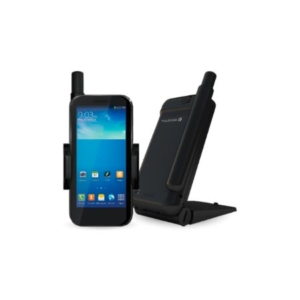Description
For Communications-On-the-Move with zero compromise on connectivity, there can only be one choice: Thuraya IP Voyager. Simple, quick and easy to install on any vehicle, connectivity to the internet can be achieved within minutes, providing reliable broadband access within locations covered by Thuraya’s congestion-free satellite network.
Work. Email. Surf. Skype. Facebook. Anywhere. On-the-Move.
Thuraya IP Voyager is a reliable, high-quality and affordable vehicular satellite terminal designed for a wide range of mission-critical on-the-move operations such as border patrol, defense and disaster response in areas inadequately served by terrestrial networks. The terminal enables users to collaborate reliably and efficiently with colleagues using video, data and VoIP to achieve mission-critical tasks, where failure is not an option.
Designed to operate at IP broadband speeds of up to 444kbps, Thuraya IP Voyager is the only vehicular terminal in the market capable of achieving streaming IP speeds of up to 384kbps as well as user definable asymmetric streaming.
Thuraya IP Voyager Features
Easy Installation
Thuraya IP Voyager is built for comms-the-move and can be easily installed in any vehicle. The antenna with its magnetic feet can be fitted in seconds and vehicular satellite unit has simple plug-and-play features that enable a hassle-free experience, enabling swift mission deployment.
Durable and dependable
Thuraya IP Voyager has been purpose-built for use in vehicles. The vehicular satellite unit has a rigid chassis with internal components that can withstand the potential of a high vibration environment. The antenna holds an IP56 Ingress Protection Rating – a globally recognized standard from the International Electrotechnical Commission – which provides protection from dirt, dust, water, oil and other non-corrosive materials to withstand the harshest environments.
High-speed streaming capabilities
Boasting speeds of up to 444kbps while on the move, Thuraya IP Voyager is the only terminal in the market capable of achieving streaming IP speeds of up to 384kbps.
Asymmetric streaming
Thuraya is the first mobile satellite services operator to provide asymmetric streaming capabilities for our broadband devices. Thuraya IP Voyager can be configured to allow users to manage their upload and download speeds to match their usage and ensure significant savings.
Unlimited data usage
With the IP Unlimited data plan, users can conduct all field operations, including video conferences, file transfers and other high-bandwidth applications at a fixed monthly rate, at no additional cost.
Congestion-free network
Our satellite network’s dynamic resource allocation minimizes any signal congestion in areas where there are high volumes of communication traffic, ensuring that you stay connected when it matters most.
FAQs
1.What is the IP Voyager?
A Vehicular satellite broadband terminal that achieves IP connectivity on the move.
2.What is the composition of the IP Voyager?
It consists of a Below Deck Unit (BDU) which sits inside the vehicle and an external roof mounted antenna connected by an RF cable, which provides the power to the Antenna from the BDU.
3.What are the power requirements?
There is one power connection on the BDU. This must be connected to a 12 or 24Vdc supply. Minimum Voltage input is 10V, Maximum Voltage is 32V, Total current from Antenna to BDU (Max @12V) is 12A, Required Fuse is 15A (fast blow, ATO blade fuse).
4.What are the product features?
- Standard IP of up to 444kbps (receive), 404kbps (send)
- Streaming IP 384kbps
- 4 x Power Over Ethernet (PoE) ports (according to IEE 802.3af)
- 802.11b/g/n wireless LAN WPA2 access point
5.How much power can the PoE ports deliver?
All 4 Ethernet interfaces support up to 15 Watts of power to each PoE powered device. The total power supplied by the PoE is limited to 30W maximum for 12V installations. The BDU automatically detects the class of the device plugged in and will apply power so that the total cannot exceed these limits. If the user attempts to connect a combination of devices that require more than this, the BDU will not power any devices that would cause the limit to be exceeded.
6.Are all PoE devices supported?
Class 4 (802.3at) PD devices are not supported.
7.How fast can the vehicle be moving whilst still maintaining connectivity and optimum performance?
8.How does the IP Voyager maintain a connection to the satellite whilst on the move?
The IP Voyager Antenna is equipped with an auto-tracking system capable of pointing and tracking the Thuraya satellite automatically within the satellite region selected. An independent GPS receiver is incorporated inside the Antenna used for satellite beam selection and autonomous UT initiated beam-beam handover.
9.What are the types of service available on the IP Voyager?
The Thuraya coverage footprint covers more than two-thirds of the globe across 161 countries in Asia, Africa, Australia, Europe and Middle East.
10.What are the types of services available on the IP Voyager?
Two types of broadband data services are available, Standard IP and Streaming IP.
- Standard IP, also known as Background IP or Variable Bit Rate (VBR) offers up to 444kbps receive speed and transmit speed on a shared mode or best effort basis.
- Streaming IP, also known as Constant Bit Rate (CBR) offers dedicated data connectivity ranging from 16kbps to 384kbps.
This is the only terminal of its type in the market that can achieve such high streaming rates on the move. Other terminals in the market achieve a maximum of 256kbps, with limitations.
11.What are the key end-user activities that IP Voyager?
All of these services whilst the vehicle is on the move:
- Broadband internet access
- Email, web mail, web browsing
- Virtual Private Network (VPN)
- File transfer (FTP)
- Video conferencing
- Video streaming
- Intranet, E-commerce
12.Who are the target subscribers for IP Voyager?
IP Voyager is targeted at vertical markets where communication on the move is essential. Users in the defense, government, telemedicine and disaster response sectors can rely on this broadband terminal to give internet access in areas beyond terrestrial network coverage.
13.What types of Quality of Service (QoS) does IP Voyager offer?
- Standard IP: This is a contentioned service that offers shared channel resources among several users. This means that in any spot beam, the number of users logged on and are actively using the service will be sharing the available channels. The throughput may vary depending on the amount of data transmitted and received by various users sharing the channel.
- Streaming IP: This is a contentionless service that offers dedicated throughput on a channel for a user. Within Streaming IP, different types of QoS are available ranging from 16kbps to 384kbps for uplink as well as downlink. In this mode, if a subscriber opts for 384kbps uplink and 64kbps downlink, the 384kbps uplink bandwidth and 64kbps downlink bandwidth is dedicated to this subscriber only. The throughput is constant during the session.
14.What are the uplink and downlink options available on Streaming IP?
Thuraya is the innovator of this service. The IP Voyager offers Asymmetric Streaming services which enable users to have numerous uplink/downlink bandwidth options. It offers unmatched flexibility for variable uplink and downlink streaming bandwidths to suit any type of dedicated bandwidth requirement.
This results in significant cost savings for the customer.
15.Which company manufactures the IP Voyager terminal?
IP Voyager is manufactured by Hughes Network Systems, Inc., USA
16.What does the IP Voyager package contain?
- IP Voyager satellite terminal
- HN221 Land Antenna
- Magnetic feet
- WLAN Antenna
- Power cable with 3-pin connector
- 15 Amp ATO blade Fuse (x2)
- SIM cover plate
- 6m RF Coax Cable (TNC-TNC)
- Installation Manual
- User Manual
17.Do I have to install software on my PC before connecting the IP Voyager?
IP Voyager is a true plug and play device. The browser on your PC that supports Java can be used to operate this terminal. You can also operate the terminal by using any smartphone or a tablet that support Wi-Fi, e.g. iPhone, iPad, Blackberry, Samsung, etc.
18.Will my IP Voyager be upgraded automatically if there is a new version?
No, you have to download the new version of the software from the IP Voyager web page on Thuraya website and then upgrade the firmware on your terminal by following the steps described in the upgrade manual.
19.Do I have to add specific applications to improve the performance of the IP Voyager?
The performance of any satellite IP link can be improved by using special Performance Enhancement Proxy software. You can easily download the software from our website or you can request for it from Thuraya Customer Care.
20.How much does the IP Voyager cost?
Please consult your account manager or Thuraya Service Partner for the cost of the terminal.

